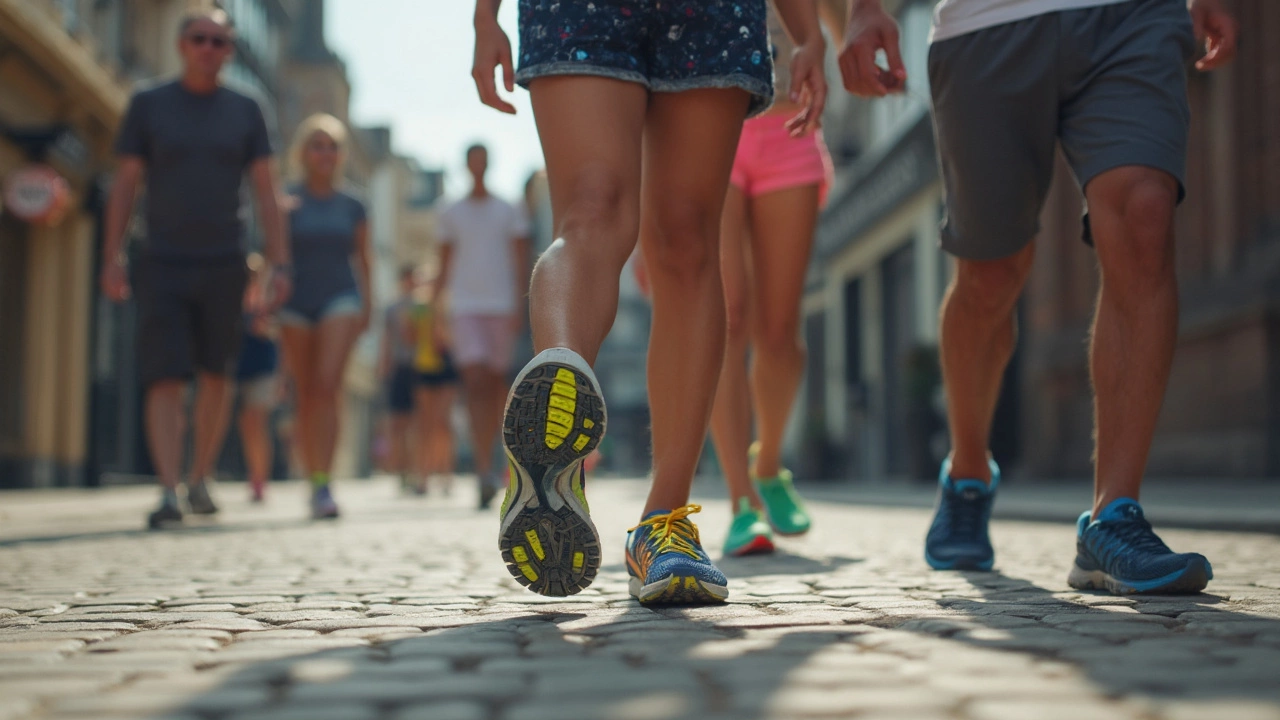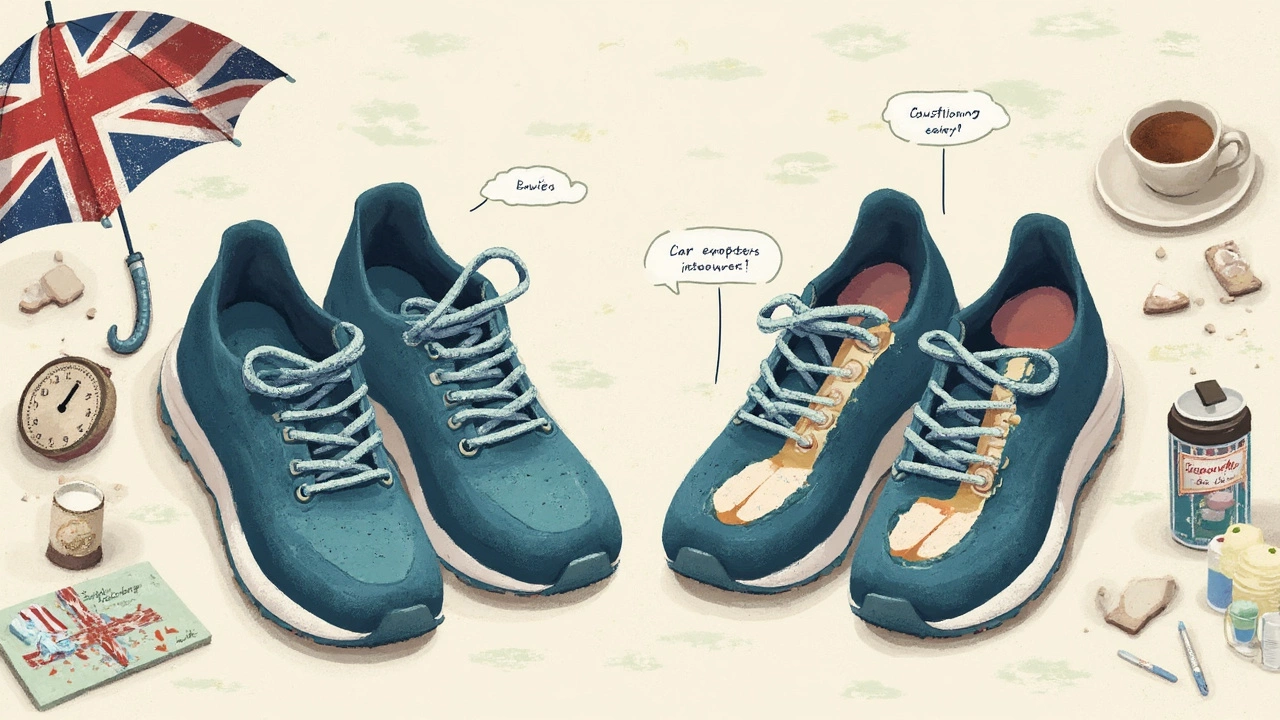Running Shoes: Can You Really Walk All Day in Them?

Spot someone at the mall or airport in sporty running shoes? That’s no accident—they're everywhere, not just on tracks. It seems like common sense: if running shoes can handle pounding the pavement at speed, surely they’re fine for hours of walking, too. But is it actually that simple?
Here's the catch: running shoes are built to manage the shock and force from running, not just the slow rolling motion of walking. Your stride, pressure points, and wear patterns all change a lot when you’re on your feet all day, just strolling instead of sprinting. Some people swear by the constant cushion of running shoes for all their errands, yet others end up with blisters or sore arches.
If you’re thinking about spending a full day in your favorite runners, keep reading. There are important details most folks miss—like how some running shoes actually lack the arch support or heel stability you want for long, slow miles on hard surfaces. The right (or wrong) shoe can make a huge difference in how your feet feel at the end of the day.
- Why People Walk in Running Shoes
- How Running Shoes Are Designed
- What Happens When You Walk All Day in Them
- Tips for Making Running Shoes Work for All-Day Walking
- When to Switch to Different Shoes
Why People Walk in Running Shoes
Take a look around and you’ll see all kinds of people using running shoes for their daily routines, not just their jogs. Why? For starters, running shoes are everywhere—nearly every shoe store has at least a dozen options, and lots of people already have a pair lying around. They look sporty and go with almost any casual outfit, so it’s often a no-brainer when you’re heading out the door.
Comfort is the biggest draw. Walkers say that extra squish under their feet feels good, especially on long days spent standing or running errands. With all that foam and cushioning, it’s easy to assume these shoes are perfect for pounding out steps at the grocery store or strolling in the park. There’s a sense that if a shoe can handle the pressure of running, it’s got to be good for walking, right?
- A large survey by Statista in 2023 showed almost 40% of Americans wear running shoes mainly for walking and daily use, not just exercise.
- Many brands even advertise their running shoes as "all-day comfort" or "ideal for every activity."
- Sneaker culture plays a big part: popular running shoe models are seen as stylish, boosting their use far beyond workouts.
Plenty of people also find specialty walking shoes expensive or hard to find, so they just stick to what they know. Plus, if you’re packing for a trip or want one pair for both exercise and sightseeing, running shoes seem like an easy solution.
| Reason | Percentage of Users (2023, US) |
|---|---|
| Comfort | 57% |
| Already Own a Pair | 34% |
| Style | 22% |
| Versatility (All-in-One) | 19% |
Of course, not every foot is the same. While lots of folks feel great in runners all day, others might notice aches in places they didn’t expect. That’s where knowing your shoes—and what your feet need—really matters.
How Running Shoes Are Designed
Running shoes aren’t just regular sneakers with fancier marketing. Every part of a running shoe is made with a specific job in mind, all focused on helping you run better and farther without trashing your feet.
Let’s start with the midsole. This is the cushy layer you feel under your foot, and it’s usually made from lightweight foam like EVA or polyurethane. It’s all about absorbing shock—think of it like little pillows keeping your joints happier while pounding the pavement. Most running shoes have more cushion than walking shoes to protect you from the extra impact that comes from running.
Another key part is the outsole. The rubbery stuff on the bottom gives grip so you don’t slip every time you hit a wet patch or loose gravel. Outsoles on running shoes often use special tread patterns and tougher rubber in high-wear areas (like the heel and toe) because those spots get hit hardest during a run.
The upper—basically everything above the sole—uses mesh or knit materials to keep your feet cool and let them breathe. Modern running shoes are pretty high-tech: flyknit, engineered mesh, overlays for structure, and even reflective strips for night runners.
Here’s a quick look at how running shoes compare with walking shoes in a couple of key areas:
| Feature | Running Shoes | Walking Shoes |
|---|---|---|
| Midsole Cushion | Thicker, high shock absorption | Moderate, more even support |
| Heel-to-Toe Drop | Usually 8-12mm | Usually 0-6mm |
| Outsole | Durable, more grip at heel/toe | Simple tread, more flex |
| Upper Construction | Lightweight, high breathability | Heavier, more structure |
One thing that stands out: most running shoes comfort your feet over miles of pounding, but only if you’re running. The heel in a running shoe is often built up higher to help cushion heel strikes, which is perfect for runners but can feel awkward or clunky if you’re walking slowly all day.
So, while the tech and cushion are there for runners, it’s not always a perfect match for those just walking around. Knowing how running shoes are built can help you pick something that actually fits your needs, especially for long days on your feet.

What Happens When You Walk All Day in Them
Clocking endless steps in running shoes isn’t as easy on your feet as you might hope. While the soft soles and flashy looks make them tempting, running shoes are designed for a totally different movement pattern than all-day strolling.
When you walk, your heel strikes first and rolls onto your toes, putting steady pressure along your foot. Runners hit the ground hard and need extra shock absorption, especially at the heel. That means some running shoes have way more heel cushion than you’d ever need for walking, but not enough support under your arch or forefoot for steady, slow mileage. If you’ve ever felt aches under your arches or at the balls of your feet after a day at the fair, this is why.
Blisters can also sneak up on you. Running shoes often fit snug to control foot movement while running, but that tight fit rubs your foot in new places during walking. Over time, this can lead to hot spots—especially if you’re wearing thin socks or your sneakers are a bit old.
Beyond comfort, your joints might not be thrilled with hours in the wrong shoe. Walking all day in max-cushioned runners has been linked to mild knee or lower back pain for some. A recent consumer survey showed that:
| Common Issue | % Reporting in All-Day Walking |
|---|---|
| Sore arches or heels | 53% |
| Blisters or rubbing | 41% |
| Knee discomfort | 27% |
| No discomfort at all | 19% |
That’s not to say you’ll have problems every time you wear running shoes for long walks. But if you start noticing any of the early signs—like aches that weren’t there earlier, or patches of rubbing on your inner foot—take it seriously. Your body is telling you something’s off.
If your number one goal is walking in running shoes all day, fit and foot shape matter a lot. People with flat feet or high arches are more likely to feel strain with the wrong midsole or support. Pay attention to your own ‘pain points’—sometimes your favorite running shoe just doesn’t double as a daily walker.
Tips for Making Running Shoes Work for All-Day Walking
Planning to spend a solid day on your feet in running shoes? Small tweaks can make all the difference between happy feet and those dreaded end-of-day aches.
- Check Your Insoles: Factory insoles in most running shoes are thin. If you want better arch support or shock absorption, buy supportive aftermarket insoles made for walking.
- Mind the Fit: Your shoes should fit snug, but not tight. Leave a thumb’s width from your big toe to the end. If you wiggle your toes easily, that’s good—crowding or sliding means blisters.
- Swap Socks: Cotton is a killer for long days. Wear synthetic or wool socks to wick moisture and keep your feet dry. This is huge for avoiding friction and hot spots.
- Rotate Pairs: Walking all day in the same pair, day after day, wears them out fast. If you’re on your feet for work or travel, get a second pair and swap every other day.
- Pick Breathable Models: Some running shoes are loaded with foam and thick uppers. Look for mesh uppers—they let your feet breathe and help keep sweating under control.
- Break Them In: New running shoes can rub or pinch for the first week. Walk in them for an hour or two around the house before you trust them all day outside.
Here’s what people notice when they make these tweaks, according to a survey by the American Podiatric Medical Association in 2024:
| Tip Tried | % Reporting Less Foot Discomfort |
|---|---|
| Supportive Insoles | 67% |
| Synthetic/Wool Socks | 54% |
| Rotating Pairs | 49% |
| Proper Fit Adjustment | 64% |
And don’t forget—if your running shoes are already worn down, cushioning and grip won’t do you any favors on a long walk. Keep an eye on the tread and midsole. If they feel flat or hard, it’s probably time for a new pair designed for walking in running shoes all day.

When to Switch to Different Shoes
If you’re clocking long hours on your feet, there’s a point where even the best running shoes just don’t cut it. The main sign? Your feet start to hurt in new ways—think blisters, hot spots, or aching arches that don’t go away after you sit down. If you notice your shoes wearing unevenly or the cushioning looks flat and lifeless, your shoes might be tired out, too.
Not all running shoes are meant for all-day walking. For example, lightweight "race" running shoes often have less support and cushioning, making them a poor choice for daily errands or work shifts. Even popular cushioned trainers sometimes lack the stability needed for slower, steady steps over hours.
- If you feel unstable or you’re rolling your ankles, switch to a shoe with more support or a wider base.
- When your heels or balls of your feet get sore or you notice any sharp pain, give your feet a break with shoes designed for all-day wear—like walking shoes or supportive sneakers.
- If your shoe’s tread is worn smooth, the midsole feels squishy, or the fabric is overstretched, it’s usually time to retire them as your main footwear for heavy use.
Switching up your shoes doesn't just make your feet happier—it can help prevent long-term problems like plantar fasciitis or knee pain. Try rotating your running shoes with other pairs so your feet get a break from the same pressure points and movement patterns. For people with jobs that require standing or walking all day, investing in purpose-built walking shoes can make a world of difference. When in doubt, listen to your feet—they’ll let you know when it's time to ditch your current pair.
Remember, no matter how cushy or high-tech your runners are, walking in running shoes all day isn’t always the answer. Sometimes, a simple switch is the smartest move for your feet.
